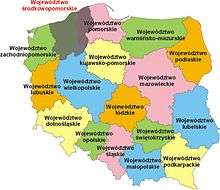Middle Pomerania
The term Middle or Central Pomerania can refer to two distinct areas, depending on whether it is used as a translation of the corresponding German or Polish terms Mittelpommern (also Mittelpommerscher Keil) or Pomorze Środkowe, respectively.
Mittelpommern, Mittelpommerscher Keil
Mittelpommern or Mittelpommerscher Keil in historical and linguistical usage denote the south-central parts of the historical Duchy, later Province of Pomerania, roughly between the rivers Zarow and Ihna (Ina).[1] This area differed from the rest of the duchy or province by the dialect of the inhabitants, who spoke the Mittelpommersch[1] variety of Pommersch closely related to Märkisch-Brandenburgisch, as well as in the town law of the cities, which was Magdeburg Law (vs Lübeck Law in the other parts).[2] Since World War II the Oder-Neisse line divides this area, reducing the German part to the Uecker-Randow district.

Pomorze Środkowe
Pomorze Środkowe in modern usage are terms coined in Poland for the area of the former Koszalin Voivodeship (1950-1975), spanning roughly from the river Parsęta (Persante) to the river Łeba, which was split in 1975 with the remains since 1999 merged into the West Pomeranian, Pomeranian and Greater Poland voivodeships. In 2003, a movement presented to the Polish Sejm parliament a petition for the recreation of the Koszalin voivodeship as the Central Pomeranian Voivodeship, signed by 135,000 people.[3]
References
- 1 2 Wolfgang Wilhelminus et al, Pommern. Geschichte, Kultur, Wissenschaft, University of Greifswald, 1990, pp.325ff
- ↑ Erika Timm, Gustav Adolf Beckmann, Frau Holle, Frau Percht und verwandte Gestalten, Hirzel, 2003
- ↑ Miroslawa Czerny, Poland in the geographical centre of Europe: political, social and economic consequences, Nova Publishers, 2006, p.57, ISBN 1-59454-603-7
See also
- Pomerania
- History of Pomerania
- Eastern Pomerania (disambiguation)
- Western Pomerania (disambiguation)
- Vorpommern
- Farther Pomerania
- Zachodniopomorskie
- Pomerelia